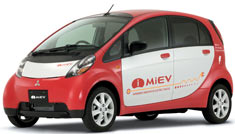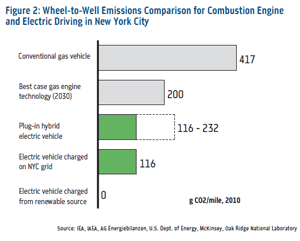 First, the good news: Someone’s finally got it right.
First, the good news: Someone’s finally got it right.
 According to a study on electric car adoption recently published by New York City and the research group McKinsey & Company, a lot more people than many of the mainstream “experts” have been saying are going to quickly ditch their gas guzzlers in favor of greener, cleaner plug-in vehicles.
According to a study on electric car adoption recently published by New York City and the research group McKinsey & Company, a lot more people than many of the mainstream “experts” have been saying are going to quickly ditch their gas guzzlers in favor of greener, cleaner plug-in vehicles.
Now, the bad news: This means that you, me, and possibly hundreds of thousands of other greenies who want an EV or PHEV are almost certainly going to have a tough time, possibly a very tough time, getting one.
Ok, so it’s not news to many of us that demand for plug-in autos is going to outstrip supply in the beginning. What this study – Exploring Electric Vehicle Adoption in New York City – does is quantify this. It also puts this claim onto the larger news radar screen.
Here are a some highlights from the study:
- Demand for plug-ins in NYC (and likely elsewhere) is going to outstrip supply for up to five years after EVs and PHEVs start rolling off major automakers’ assembly lines. The study projects that, by 2015, up to 14-16% of all new vehicles purchased by New Yorkers could be electric vehicles and concludes that, “the group of (early adopters) appears to be larger in number than what auto manufacturers can likely produce in the next five years, both in terms of total numbers of EVs as well as the specific vehicle models that these early adopters will prefer.”
- Early adopters – and, again, the study suggests there will be a lot of these – are going to be quite flexible. They’re willing to adapt their driving behavior to fit the new mode of transportation.
- Early adopters aren’t, as some studies have suggested, obsessed with “range anxiety” or the fear that their EV will suddenly run out of power. In fact, according to the study, “building high-density public infrastructure does not seem to cost-effectively influence the behavior of (early adopters).” In other words, early adopters aren’t especially concerned about having a charging station on every corner. They want to be able to charge their EV where they store their car at night and they could use assistance and help setting up a “home” charging station. But that’s enough for them.
- Early adopters would be willing to change where they park to charge their electric vehicles – even if they would have to pay a premium to do so.
 The projected level of adoption of EVs should not threaten the stability of the electric grid as long as most chargers are “smart” and charge their cars during off-peak hours.
The projected level of adoption of EVs should not threaten the stability of the electric grid as long as most chargers are “smart” and charge their cars during off-peak hours.- The mix of generation sources that provide power to the New York City electric grid would prove favorable to electric vehicles, as approximately 40% of the electricity consumed in New York City is generated by “clean” energy sources such as nuclear and hydroelectric power.
- Twenty-one percent of prospective car buyers in NYC are potential early adopters of EVs.
- The early adopters include what the study authors term the ‘Green Auto Aficionados’ (7 percent). This group uses a car every day, loves the latest car technology and wants to be green. It is also “willing to pay an upfront premium” to buy an electric car.
- The second group of early adopters are the ‘Simple Greens’ (7 percent) They use a car on weekends and for occasional errands. They’re looking for ‘basics in a car’ but want to be ‘very green’. They’re willing to pay a premium for an EV but are more budget conscious than the first group.
- Finally, there are the ‘Progressive Pragmatists’. They are essentially the same as the ‘Simple Greens’ but are not as concerned with being green as the former group.
The study suggests that the most effective approach for NYC (and presumably other municipalities) in terms of promoting EVs is to tailor its approach to the specific knowledge levels, needs, and desires of the early adopters while “efforts focused on other consumer segments should wait several years”.
This conclusion represents a thoughtful, and refreshing, step away from the sometimes panicked shrieks about how we can’t possibly move forward with EVs without a charging station on every street corner.
{googleAds}
<div style="float:left">
<script type="text/javascript"><!--
google_ad_client = "pub-7703542917199961";
/* 200x200, created 12/8/09 */
google_ad_slot = "7950368454";
google_ad_width = 200;
google_ad_height = 200;
//-->
</script>
<script type="text/javascript"
src="http://pagead2.googlesyndication.com/pagead/show_ads.js">
</script>
</div>
{/googleAds}Early adopters, at least many of them, clearly get it: They’re not going to run out of power. They’ll charge up at home, have something approaching a 100-mile range to work with – this will be more than enough in terms of where they actually drive the car – and then plug their car back into its home charging station when they return home.
It’s not rocket science, or suddenly driving off a cliff. Although it’s definitely going to be a bit pricey for early adopters, switching to an electric car is easy, convenient, and not especially complicated, as thousands of current electric vehicle owners — a few of whom we’ve interviewed here at SolarChargedDriving.Com — can attest.
You can download Exploring Electric Vehicle Adoption in New York City at: http://www.ci.nyc.ny.us/html/om/pdf/2010/pr10_nyc_electric_vehicle_adoption_study.pdf
Related stories–>
- EVs on verge of re-making history
- EV/PHEV guide
- Electric Ford Focus to charge onto scene in 2011
- Want a Nissan LEAF? Get on the list
 Like this story? Interested in the solar-EV/PHEV synergy? Join our Sun Miles™ Club and start meeting & interacting with other people around the world who want to drive, or already are driving, their cars on sun! Register to join us today!
Like this story? Interested in the solar-EV/PHEV synergy? Join our Sun Miles™ Club and start meeting & interacting with other people around the world who want to drive, or already are driving, their cars on sun! Register to join us today!



 The projected level of adoption of EVs should not threaten the stability of the electric grid as long as most chargers are “smart” and charge their cars during off-peak hours.
The projected level of adoption of EVs should not threaten the stability of the electric grid as long as most chargers are “smart” and charge their cars during off-peak hours.